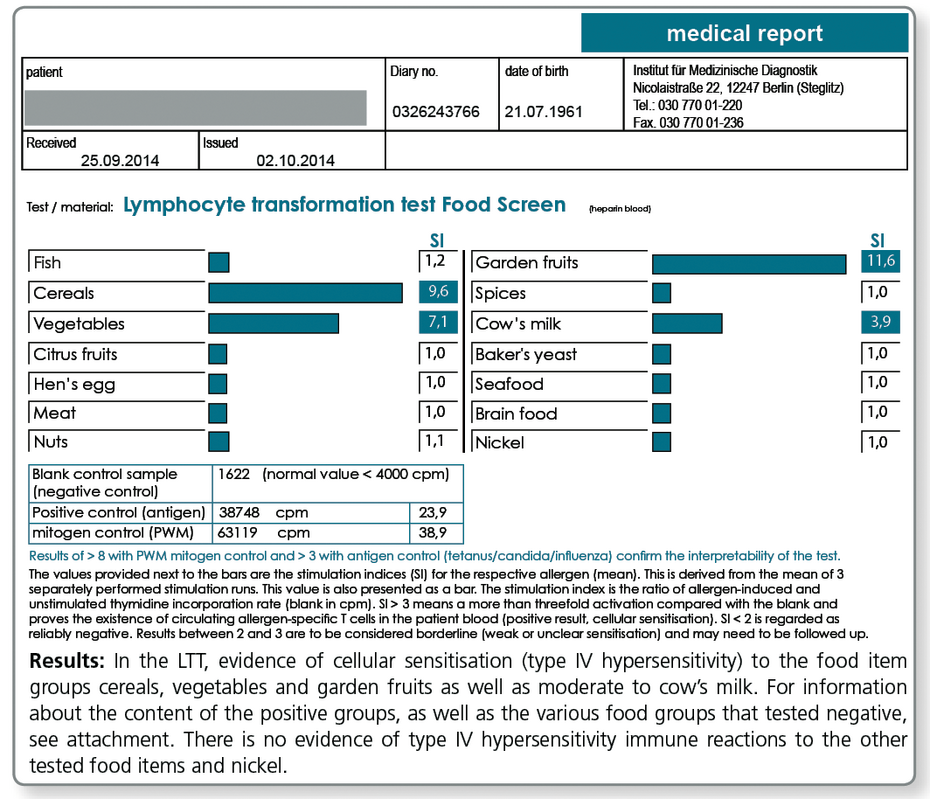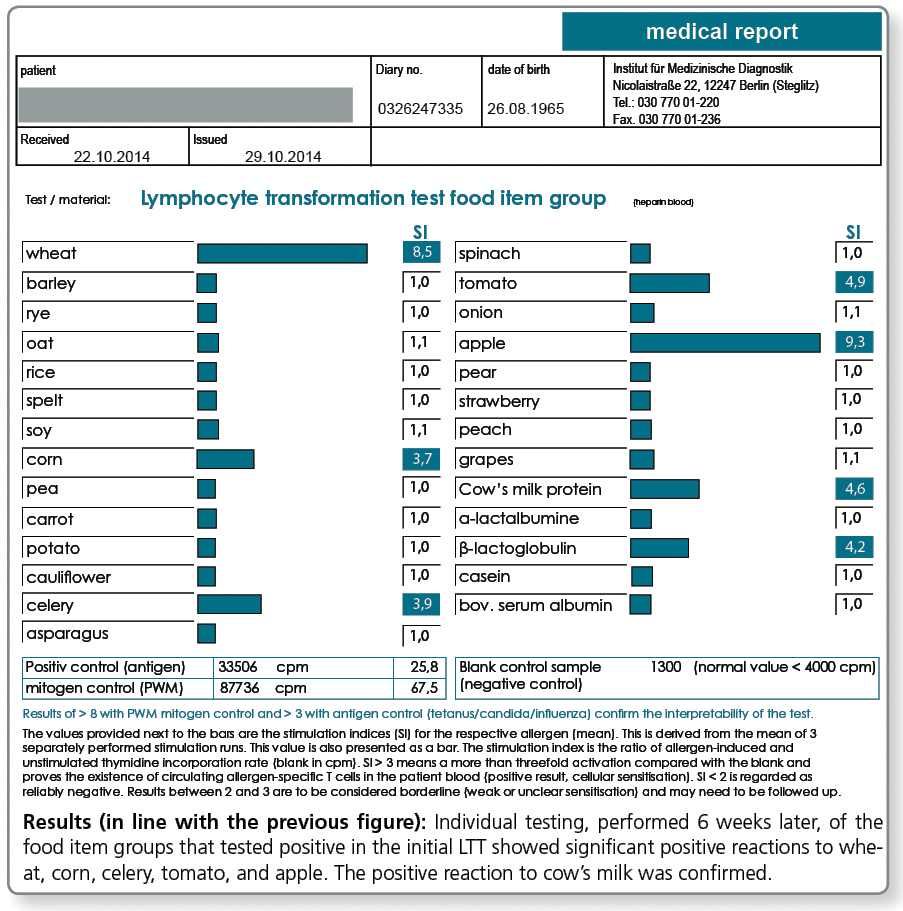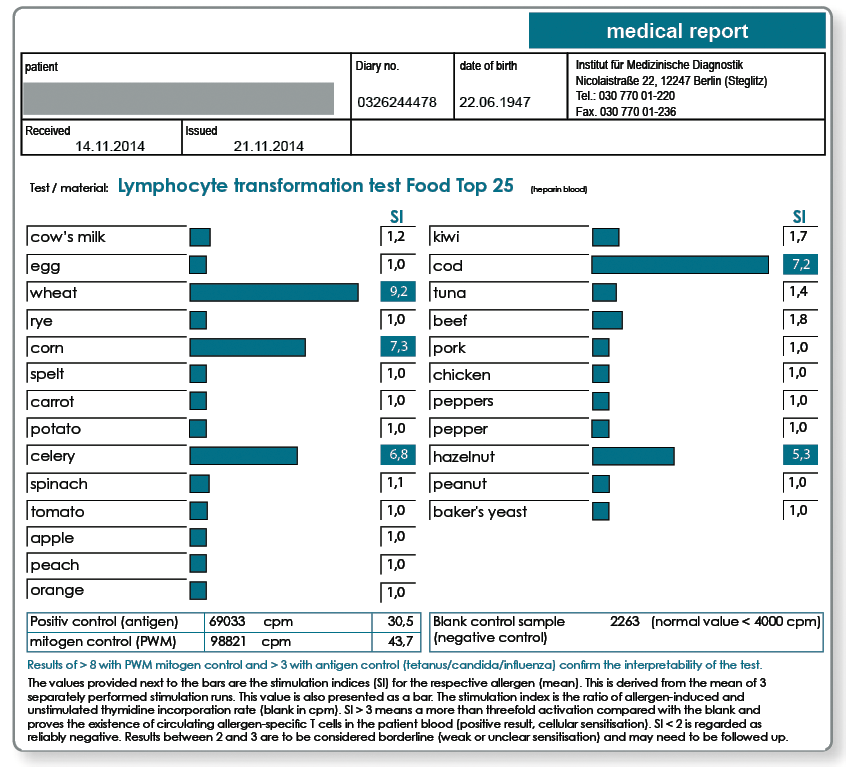LTT - food
Use of the LTT to detect type IV sensitisations to food
Without any doubt, food intolerances have steadily increased over the last 20 years. Information about the frequency of those affected in Germany varies between 11 and 41%.
The term food intolerance is an umbrella term for all unwanted symptoms or diseases associated with the consumption of specific food items.
Besides toxic reactions (food poisoning etc.) and structure-related problems (stomach resection, diverticulum, pancreatitis etc.), the food intolerances are divided in two reaction types: IMMUNOLOGICAL and NON-IMMUNOLOGICAL.
As shown in the following figure, type IV allergies detected with the lymphocyte transformation test belong to the immune-mediated food intolerances and should be distinguished from type I allergies, the pseudo-allergies and also from celiac disease.
| IMMUNOLOGICAL | |
|---|---|
| ALLERGIES | TYP I (immediate type) TYP IV (delayed type) Cross allergies to inhalation allergens |
| AUTOIMMUNE DISEASE | Coeliac disease |
| PSEUDO-ALLERGY | Food additives |
| NON-MMUNOLOGICAL | |
|---|---|
| ENZYME DEFECTS | Lactose intolerance Fructose intolerance Histamine intolerance |
| FRUCTOSE malabsorption | |
| Impaired PHYTOSTEROL absorption | |
The classical food allergy is a type I reaction, mediated by specific IgE antibodies.
However, particularly among adults other intolerance reactions may also occur. Some authors report up to 50% IgE-independent mechanisms. Clinical reaction patterns indicative of intolerances of the delayed type (allergy of type IV) are increasing seen in adults.
Food intolerance of the delayed type IV should always be taken into consideration if:
- the reaction occurs only after some hours and lasts for several days or longer.
- eczematous skin changes, gastrointestinal symptoms, myalgia and arthritic symptoms are the main complaints.
The lymphocyte transformation test (LTT) as a diagnostic tool for type IV sensitisation to food has become an established and validated method of the modern laboratory diagnostics.
The use of the LTT to test for food proteins became possible with the utilisation of LPS-cleaned allergens in the diagnostic testing and methodological changes to the LTT which increased its specificity und sensitivity (see von Baehr et al. Journal Immunol. Methods 2001; 151: 63-71).
The LTT is used in food intolerances in particular when no corresponding specific IgE antibody have been detected in the CAP test (a common situation in adults) and when non-allergic food intolerances, such as coeliac disease, lactose intolerance or histamine intolerance, can be ruled out by the clinical presentation or laboratory diagnostics.
There are 2 test profiles available:
- the LTT Food Screen 75 or alternatively
- the LTT TOP25 Food
In LTT Food Screen 74 food items and in addition the potential contact allergen nickel, frequently present in food items as a contaminant, can be studied in one test run.
The food test is performed in groups of 2 to 9 allergens.
| Ingredients of the Food Test Groups in the LTT Food Screen | |
|---|---|
| Meat | pig, chicken, beef, turkey, mutton (lamb), goose, duck |
| Fish | trout, eel, halibut, salmon, cod, carp, tuna, herring |
| Seafood | lobster, shrimp, crayfish, sole |
| Cereals | wheat, barley, rye, oat, rice, spelt, soy, corn |
| Brain food | Black tea, hops, cocoa beans, coffee beans, brewer's yeast |
| Milk | α-lactalbumine, casein, β-lactoglobulin, BSA (bovine serum albumin) |
| Nuts | peanut, walnut, hazelnut, Brazil nut, pistachio, almond, cashew nut |
| Garden fruits | apple, pear, strawberry, peach, grapes |
| Citrus fruits | Orange, grapefruit, lemon, pineapple, mandarin, avocado, kiwi fruit, banana |
| Spices | mugwort, garlic, coriander, paprika, pepper, vanilla, cinnamon, aniseed |
| Vegetables | pea, carrot, potato, cauliflower, celery, asparagus, spinach, tomato, onion |
| Hen’s egg | egg yolk, egg white |
| Yeast | baker's yeast |
| Nickel | as a frequent metal ion pollutant |
The LTT Food Screen has the advantage that it covers with the tested food items approximately 98% of all known type IV food intolerances. A disadvantage is that the testing in this screening test is performed in groups (e.g. cereals, nuts etc.) and a positive result for one group needs a follow-up testing to specify the single allergens of that group. This requires a second blood collection.
In the LTT TOP 25 food items, the insights from the LTT Food Screen 75 gained over many years were used to select the 25 of allergens which most frequently tested positive. In the LTT, these are tested as single allergens already in the initial test.
The advantage of this profile is that it does not require follow-up testing for positive screening results, eliminating the need for a second blood collection and any costs for follow-up testing of positive groups. According to statistical data, approx. 92% of the type IV sensitisations to food are recognised.
The food items included in the LTT Food TOP 25 are shown in the following results report.
What material is required for blood collection?
- LTT Food Screen 75: 20 mL heparin blood and 5 mL whole blood
- LTT to individual food groups (according to result of the LTT Food Screen): per group 20 mL heparin blood and once 5 mL whole blood
- LTT Food Item TOP 25: 30 ml heparin blood and 5 mL whole blood
Please request the appropriate collection materials (LTT blood collection sets) from the laboratory free of charge.
No more than 24 hours should elapse between the time the blood is collected and the receipt of the sample in the laboratory. During this time the blood samples should be stored at room temperature. Blood samples for cellular function tests should not be stored in the fridge!



